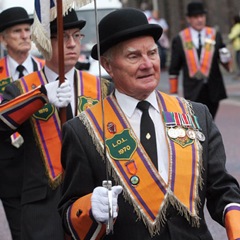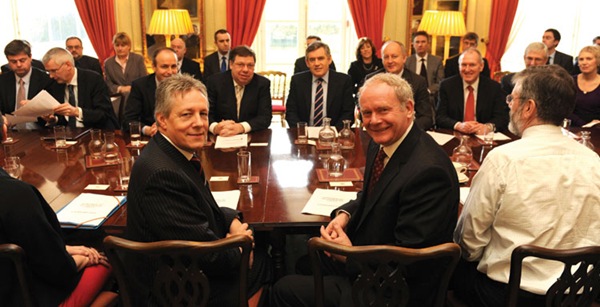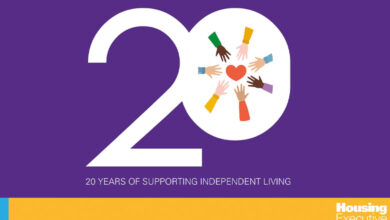The deal unpacked
agendaNi unpacks the Hillsborough Agreement and the early steps after its launch.
Launched with less hype than its predecessors, the Hillsborough Agreement is the product of two weeks of gruelling negotiations in the castle, while the media mostly looked on from the wintry outside.
This latest step in the political process is now public for anyone to read and comment on, although given the efforts which led to its creation, some have cast doubt on whether it will now be amended.
Essentially, the four major subjects which feature highly in the agreement and its aftermath are: justice devolution, parading, language and governance.
Justice transfer
At St Andrews, the two governments predicted that if Sinn Féin supported the police, the Assembly should be able to request justice devolution “by May 2008”. This was written up as a target rather than a deadline. Sinn Féin backed the PSNI in January 2007 and republicans expected the devolution of justice in return. Symbolically, it would move some justice powers away from London to Belfast, and out of the NIO’s hands (agendaNi issue 34, page 64).
Mainstream unionists support justice devolution in principle but have been more cautious, saying that “community confidence” on their side depended on a financial package, progress on parading and evidence that the Assembly could handle its current responsibilities properly.
The envisaged “community consultation” on the agreement is therefore mainly aimed at unionists and will finish up before the 9 March Assembly cross-community vote. If the Assembly agrees, and Parliament passes the necessary legislation, powers will be devolved by 12 April.
A justice minister can only be elected once devolution has taken place, again using a cross-community vote. Technically, any MLA could nominate a justice minister although the First Ministers will make clear their preferred choice i.e. the candidate “best able to command cross-community support” in the Assembly.
The minister will draft an addendum to the Programme for Government and bring this to the Assembly for approval. Basically, this will allow MLAs to agree policies which the minister will then implement. Sinn Féin and the DUP want the following topics to be covered by the justice addendum:
- Public confidence;
- Avoidable delay;
- Rehabilitation;
- Recidivism (i.e. re-offending);
- Victims’ interests;
- Witnesses’ interests.
Practically, these justice policies could involve:
- Full provision of legal aid for disadvantaged people;
- A sentencing guidelines council;
- A comprehensive strategy to manage offenders;
- A women’s prison;
- A victims’ code of practice, setting out minimum standards expected in the system;
- Reviews of alternatives to custody, the Prisoner Ombudsman’s powers, children in the criminal justice system and the prison regime.
Again, this is only tentative. It would be up to the minister to propose these initial policies and for the Assembly to approve them.
Alliance put forward draft proposals on 8 February, which endorse most of the above points. Few could disagree with its title – ‘Safer Communities and Justice for All’ – but the party’s hint is that if you want that to happen, you need to have a ‘Cohesive, Shared and Integrated Community’. This makes community relations an important priority in their justice policy e.g. removing peace walls, a dedicated team to deal with hate crime, encouraging agencies to work towards a shared future and defending shared spaces.
Executive relations 
The minister would have equal standing in the Executive, when it comes to voting, attending and controlling his or her officials. All ministers, though, have to bring cross-cutting issues, proposals for new laws and financial requests to the Executive table for approval. The justice minister will be no different.
For urgent and confidential matters, the ministerial code could be amended to say how these should be handled. The justice minister is expected to bring forward proposals on these to the Executive. Final changes are expected to be made before the summer recess; the Assembly’s term ends on 2 July.
In the meantime, major decisions by the justice minister will normally be granted “retrospective approval” by the Executive i.e. the decision will be carried out and other ministers will judge whether that was right or wrong after it is taken. However, this approval could be withheld by the First and deputy First Ministers, acting jointly. They could also require “any matter” to be brought to the Executive for consideration.
The justice minister will be free to make his or her own ‘quasi-judicial’ decisions; Kenny MacAskill’s release of the Lockerbie bomber is an example of one.
Alliance and the SDLP have both shown an interest in the post. The SDLP nominated North Belfast MLA and barrister Alban Maginness on 8 February. David Ford went forward on 25 February.
For his part, Jim Allister questioned why Brian Cowen was at Hillsborough given that devolving policing and justice was an internal matter within the UK. The NIO said in response that the Irish Government has an “evident and proper interest” in fulfilling the Belfast and St Andrews Agreements, and played a “highly effective and constructive role” in the discussions.
Parading
The Parades Commission, set up in 1997, has usually had a frosty relationship with Protestant marching orders. St Andrews proposed a review into parading, “with a view to developing” an agreed long-term strategy. Paddy Ashdown has been leading it since April 2007; his interim report (April 2008) suggested that local councils take decisions, with appeals going to OFMDFM.
Given the views of some grassroots supporters, parading ‘reform’ is a mainly unionist demand. The DUP has been more vocal but both main unionist parties want the current framework replaced; nationalists think the current system generally works and want nationalist residents’ rights protected.
The agreement says a “new and improved” framework is needed but the Parades Commission will continue until this is put in place. The first step was setting up a six-strong working group, appointed by the First Ministers, which is tasked with bringing forward proposals for this framework.
At the minimum, these will cover:
- Notifying the authorities about parades and assemblies;
- Objections to those events;
- Dialogue and mediation;
- Independent adjudication;
- A legally enforceable code of conduct;
- Freedom from harassment.
The First Ministers will “promote and support” the group’s proposals, which suggests that they will be binding. A public consultation will then follow, after which a Parades Bill will be finalised.
Two major aims are set out:
- Transferring parading to Stormont; and
- Getting the Parades Bill through the Assembly.
As agendaNi reported last month (page 64), MLAs had agreed that parading should be held back from Stormont. This has therefore been reversed. Local accommodation is the main priority, with lessons learnt from successful models such as Derry. Local elected representatives would also become involved in resolving parades disputes.
The DUP insisted that nothing was delivered until everything was delivered so some initial progress on policing was necessary by 23 February before the justice devolution vote on 9 March.
Language
St Andrews promised that the British Government would “introduce an Irish Language Act reflecting on the experience of Wales and Ireland and work with the incoming Executive to enhance and protect the development of the Irish language.” Ulster-Scots would also be developed.
Devolution left the decision on whether to legislate up to the Assembly; DUP ministers refused to do. DCAL, has though, been working on an indigenous minority languages strategy. Nationalists have called for an Act, believing the Executive has inherited the Government’s responsibility, while unionists remain opposed. Alliance is sceptical, believing that non-indigenous and sign languages should not be ignored, and warning of the financial costs.
In the midst of the talks, on 1 February, the UK and Irish Governments published a plan to roll out Irish language channel TG4 across Northern Ireland.
Shaun Woodward said the Government would “support the Executive, in any way it can, in the development and implementation of its Irish language strategy”; no strategy had yet been published.
“Broadcasting has a key role to play in the continuing development of minority languages,” he added. Micheál Martin, meanwhile, looked forward to “early agreement” on an Irish language strategy and re-emphasised the Irish Government’s commitment to an Irish Language Act.
The move was part of a wider agreement on broadcasting, including RTÉ access and digital services.
It also fulfils Sinn Féin’s 2005 manifesto commitment to see TG4 “readily accessible” in all areas of the north; the SDLP made the same pledge. Irish language legislation is not mentioned in the agreement and is therefore still an “outstanding issue”.
Gerry Adams leaked a side deal involving £20 million for Irish language broadcasting on 15 February, and the news was followed up by confirmation of a £5 million Ulster-Scots broadcasting fund by Nelson McCausland. As broadcasting is not devolved, the money came from Westminster.
Their respective parties, and enthusiasts for both tongues, welcomed the allocation but the general public’s reaction through the media showed that many people believed the money would be better spent on essential public services.
When that point was put to the NIO, a spokesman told agendaNi that that UK Government “recognises the close connection between language and identity issues and understand the concern of individuals to see the language in which they were brought up, or which is used in their communities, respected.”
Down to work
Three extra working groups are also being convened.
The first focuses on how to improve the Executive’s workings, as the UUP and SDLP have felt sidelined and relations have been tense between the top two parties. It will be made up from all Executive parties and chaired by Sir Reg Empey and Margaret Ritchie. Work was to commence by the end of February.
The second group, chaired by the OFMDFM junior ministers, is to “oversee an exercise of trawling for and identifying all Executive papers and decisions which are still pending”. The clear implication is that OFMDFM did not have a list of these papers or decisions before the agreement was published. This would report back to the Executive by the end of February.
Thirdly, following on from St Andrews, the First Ministers will identify “all matters contained within it which have not been faithfully implemented or auctioned.” They would report back to the Executive by the end of February and the Executive will then be asked to set up a working group.
Again, this implies that a list had not yet been drawn up. However, the following main “issues” appear to be outstanding:
- A single equality Bill;
- Irish language legislation;
- A North/South consultative forum;
- A North/South parliamentary forum;
- An east-west inter-parliamentary framework;
- A standing secretariat for the British-Irish Council.
The working group will again be chaired by the junior ministers and make an initial report by the end of March. A programme to put its conclusions into practice will be agreed by the First Ministers within four weeks of that report.
Plan B?
With no guarantee that the deal will succeed, it is also worth considering how it could fail and, if so, what could happen next. Peter Robinson’s plan to resign as First Minister if Sinn Féin does not play its part is the mirror image of the republican threat to collapse the Assembly last year. An Assembly election or restored direct rule could follow.
The format of direct rule will, of course, depend on which party is in power at Westminster. Neither option would be attractive to the DUP at this stage. The governments and two main parties have publicly and jointly stated that they want the agreement to work. That in itself ensures that it would be somewhat embarrassing for any of them to undo it.






